Claussen Pickles are kosher dill pickles at their crunchiest, saltiest best! These homemade Claussen pickles taste like the commercial ones you find at the store, but better. And better yet, they’re ridiculously easy to make!
Whether you’re new to pickle making or a pickle veteran, you NEED to make these half sour pickles! And wonder of wonders, you don’t need to know how to can to make these super fresh, crunchy pickles! Claussen dill pickles are meant to be eaten fresh.
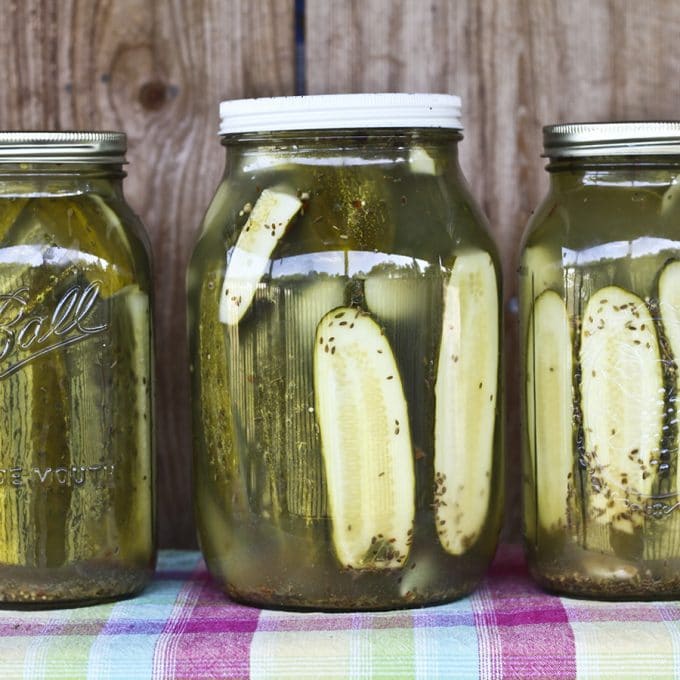
Homemade Claussen Knock-Off Pickles: Always crunchy and garlicky, this perfect homemade pickle recipe requires no special equipment, & no canning experience.
It’s common knowledge that I have a salty tooth rather than a sweet tooth. When the weather does what it has been doing lately (making us all do our best Shadrach, Meshach and Abednego impersonations) I can’t think of a single thing I find more refreshing than an icy-cold, salty, crunchy pickle.
It’s not just me, it’s my whole family: mother, sisters, brothers, cousins, aunts, grandparents, kids, husband… I married a man who loves pickles so much he eats the pickles and then drinks the juice from the jar.
I grew up eating my Grandma’s homemade dill pickles like the supply was endless and moved on to canning my own pickles as soon as I had a kitchen of my own. There’s just something about a homemade dill pickle that makes me happier than any pickled cucumber ever should.
My little sister, Jessamine, and I compare our homemade pickles from year to year the way some people compare wine vintages.
Dill Pickle Recipe
But there is one pickle that stands head-and-shoulders (were pickles to *have* heads and shoulders) above all others. I’m talking about the pickles you see here. That’s right: Homemade Claussen Dill Pickles.
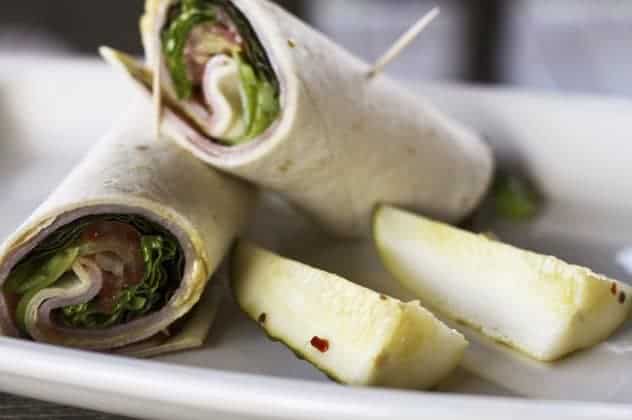
Recipe for Claussen Pickles
What do you need in order to make this recipe for Claussen Half Sour Pickles at home? Let’s get a quick list for both ingredients and equipment out of the way, shall we?
Equipment for Making Claussen Pickles at Home
- A Glass gallon jar or 4 glass quart jars or other food safe container with a tight fitting lid
- Measuring cup
- Chef’s knife or paring knife
Ingredients for Making Homemade Claussen Pickles Copycat
- Small to medium size pickling cucumbers (check your local farm stand or farmer’s market!)
- Apple Cider Vinegar (don’t fret- it doesn’t taste like apple cider and isn’t even a little sweet!) or white vinegar
- Kosher Salt
- Garlic
- Dill (either fresh or dill seed)
- Pickling spices (available here)
A quite note on your vinegar choice: I opt for apple cider vinegar because it’s a smoother vinegar than white vinegar. It does not impart any sweetness or apple taste to the pickles whatsoever.
If you can’t find it (pssst. It’s right next to white vinegar in even moderately stocked grocery stores) or don’t feel like buying it, you can most certainly substitute white vinegar. It’ll just taste a little sharper. (And technically store bought Claussen pickles have white vinegar, so you do you!)
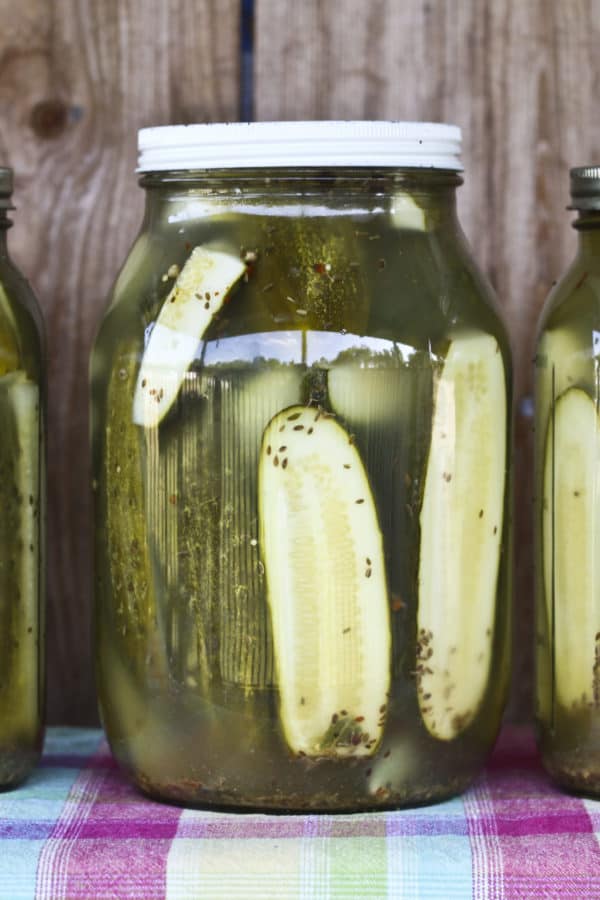
And ya’ll. These homemade half sour pickles are so easy to make it’s almost criminal.
The hardest part is the 2 to 4 day wait for them to be done. Truth be told, though, I’ve snacked on them the day after I made them and been a very happy camper.
Claussen Pickle Recipe
These are homemade refrigerated deli pickles, also known as Lithuanian half-sours, also known (in the commercial equivalent) as Claussen dill kosher pickles, also known as the best pickles ever known to mankind.
Here’s the thing. While I do love my other homemade pickles dearly (otherwise why would I continue canning ninety-something quarts year after year after year), these are by far my all-time favourites.
CRUNCH. That’s what you hear when you bite these. There is no flop, no squish, no soft pickles. These things almost bite back.
This also happens to be the perfect dill pickle recipe for beginning pickle makers. If you’re not into canning, these refrigerator pickles are a godsend. Even if you ARE canning obsessed, like yours truly, this Claussen pickle recipe should be in your pickle repertoire too.
Please note that this Claussen pickle recipe is not suitable for canning. The brine is fermented and not very acidic, which means it has far too high a PH to can safely. If you’re looking for a great canned dill pickle recipe, try this home canned garlic dill pickle recipe.
Refrigerator Pickles
Here’s where we get into the best part of this pickle recipe (aside from the crunch and flavor). You don’t have to cook anything to make these pickles; not one single thing. The brine is stirred together, the cucumbers are rinsed, trimmed and stuffed into a jar with garlic cloves and spices.
These half sour pickles are NOT CANNED. They are simply put into jars. Amen!
When it’s summer time and the idea of turning on the stove makes me want to crawl into an (air conditioned) hole, these pickles are a welcome treat. Not only is that cold crunchy refrigerator pickle waiting to cool me off at the end of the prep time, but I don’t have to heat up my kitchen by even one single degree to get there.
Remember that pickling isn’t just for cucumbers, either! Try out our Pickled Brussels Sprouts, Quick Pickled Red Onions, and famous Candied Jalapenos!
How to Make Pickles FAQ
Please, please, please give these a go even if you have never made a pickle before. There is nothing scary or intimidating here. Wash, slice, stuff, stir, pour, sit, wait.
- Trim 1/8-inch from the blossom end of each cucumber and slice them in half lengthwise or into quarters. The size you choose depends on how large your cucumbers are and how big you want the pickles to be when they’re done. This helps minimize the chances of soft pickles.
- In a gallon jar (or large, wide-mouth, food-safe container) layer the dill heads or seed, pickling spice or mustard seed, and garlic cloves and sliced cucumbers. If you’re dividing the cucumbers up between smaller containers, just divide the garlic and spices evenly between the containers, too.
- Stir your brine together in a separate container. You WILL have more brine than you have space for in the jars, but that’s why you pack the spices in the jars. Just store extra brine in a jar in the refrigerator and use it to top off your pickles if the brine starts evaporating.
- Pour the brine over the cucumbers, taking care to make sure all of them are fully submerged. If needed, place a plate or mug or other ziploc bagged can of beans on the cucumbers to weigh them down and keep them under the brine!
- Cover the jars lightly not tightly and leave out of direct sunlight on the counter for two to four days or until the pickles are picklicious.
- If your kitchen is pretty hot or humid, you can stash them directly in the refrigerator. They’ll just take a couple of days longer to get fabulous. Your patience will be rewarded.
On the plus side, the wait is only two to four days which is significantly less than the six week wait of the canned pickles. Besides, as I said, there is the crunch factor
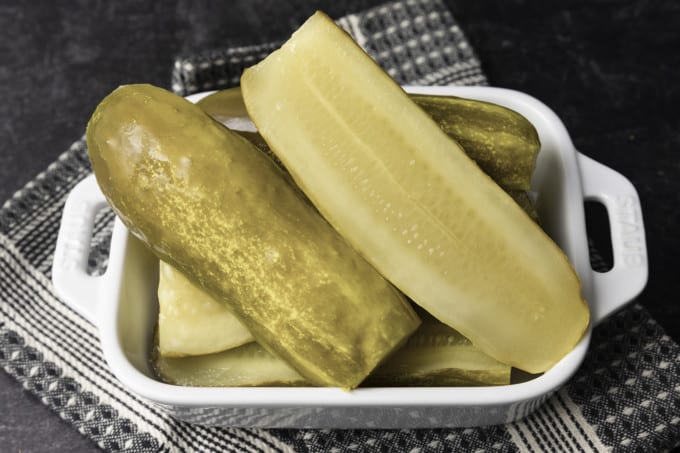
Troubleshooting Your Homemade Claussen Pickles
These pickles are easy peasy to make, but there still may be a couple of things that pop up from time to time that make you go “Hmmm…” In no particular order, here are some of the most commonly asked questions about them and some answers!
- Why is my pickle brine cloudy? Okay, I lied. This is the most common question and that’s because the brine becomes cloudy naturally as a consequence of fermentation (which is what’s happening here.) No worries.
It’s all natural. This half sour pickle recipe (more on this to come) is a fermented pickle recipe and that just happens.
Another possible cause of intense cloudiness or discolouration in your brine is using table salt. The iodine in table salt can also give off flavours to your pickles, so it’s best to stick with kosher salt or pickling salt for these bad boys! - Is the scum, foam, or film on top of my pickle brine dangerous? It’s that pesky (and delicious) fermentation again! This is another thing you don’t have to worry about.
Just scrape it off with a spoon, discard, and top off with a little of that extra brine you whipped up. (See the recipe card for details.) But do remove the scum or it could cause your pickles to go bad. - My pickles went soft! How do I prevent this? This particular tragedy could have two causes.
First, you may have failed to remove enough of the blossom end of the cucumber. There is a naturally occurring enzyme in the blossom end of cucumbers that causes pickles to break down and become soft if it is not removed. Next time, just slice more off.
Second, you may have started with less than spectacularly fresh cucumbers. An older cucumber has had longer for the aforementioned enzyme to kick in, and it has already started its work.
The best solution for this issue is to use cucumbers that have either been picked fresh that day or have been refrigerated steadily since very shortly after being picked a couple of days previously. - Why did my pickles go bad? See that second reason in the “why did my pickles go soft” bullet point? That’s one culprit.
Other potential causes of spoiled pickles are using unwashed cucumbers or fresh dill, old or decayed garlic, bad spices, lower-than-5%-acidity-vinegar, failing to remove the scum from the brine or to keep the pickles submerged in the brine, or storing your pickles in warmer conditions. When in doubt, stash them in the refrigerator! - Why is there mold on my pickles? First, you have my condolences. Second, it’s because your pickles didn’t stay submerged in the brine. That brine has enough salt and acid to prevent mold growth if the cucumbers stay under the surface.
If you’re having trouble finding something that fits in the jar to keep this from happening, try popping a can or two of tomato paste or canned beans in a zipper top bag and gently inserting that into the jar. It should weigh it down enough to do the job. - Should I worry about the white sediment in my jar? This is another one in the “don’t sweat it” category. There are two potential reasons and both are completely harmless.
It’s either a natural consequence of the fermentation or anti-caking agents in the salt. Neither harms the pickles or effects the flavour, so don’t worry! - Why is my garlic blue/green/purple? As long you inspect the garlic before it goes into your jars and it is fresh as a daisy, you have nothing to worry about. It could be the type of salt you used or it could be the variety of garlic. Some types of garlic have a natural propensity to change pretty colours in vinegar.
It also may mean that your pickles were exposed to light. When garlic is exposed to light, it starts producing chlorophyll which is green. It also may indicate that your garlic is more mature.
In that case it is caused by sulfur compounds that naturally occur in more mature garlic reacting with minute traces of copper in the vinegar., but as long as there are no other signs of spoilage (soft or squishy texture, funky smell, discoloured spots), you’re good to go.
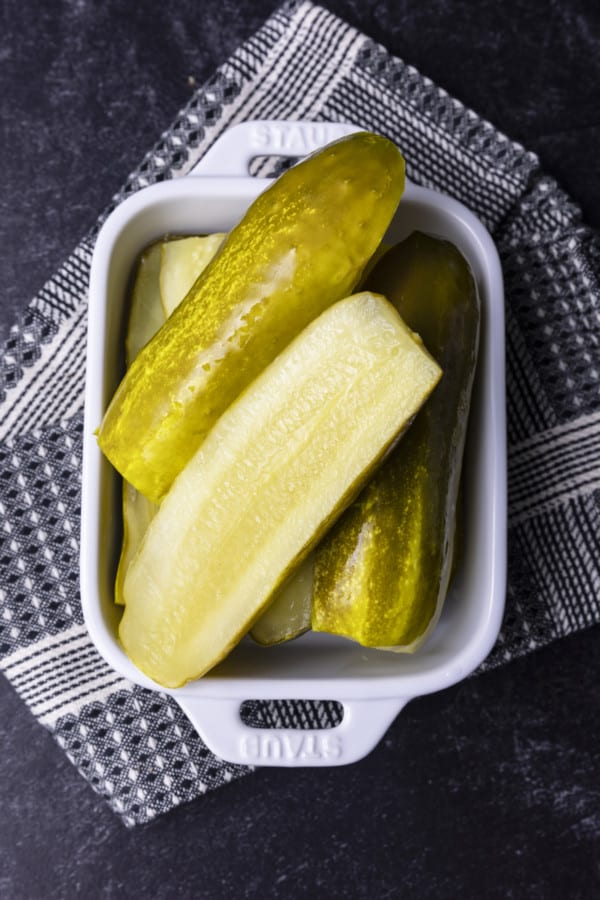
IMPORTANT NOTE: Because there is so much diversity in temperature, humidity, age of cucumbers, etc… involved in this recipe, please check your half sour pickles starting at 24 hours for doneness. If the pickles smell/taste pickley, move them to the refrigerator. Do not keep them on the counter longer than 4 days.
ANOTHER IMPORTANT NOTE: These pickles are not suitable for canning. They’re simply not acidic enough to can safely, and that is in addition to the fact that you’d ruin that perfectly crisp texture by introducing heat to the party.
What can I serve with these Homemade Claussen Knock-Off Pickles?
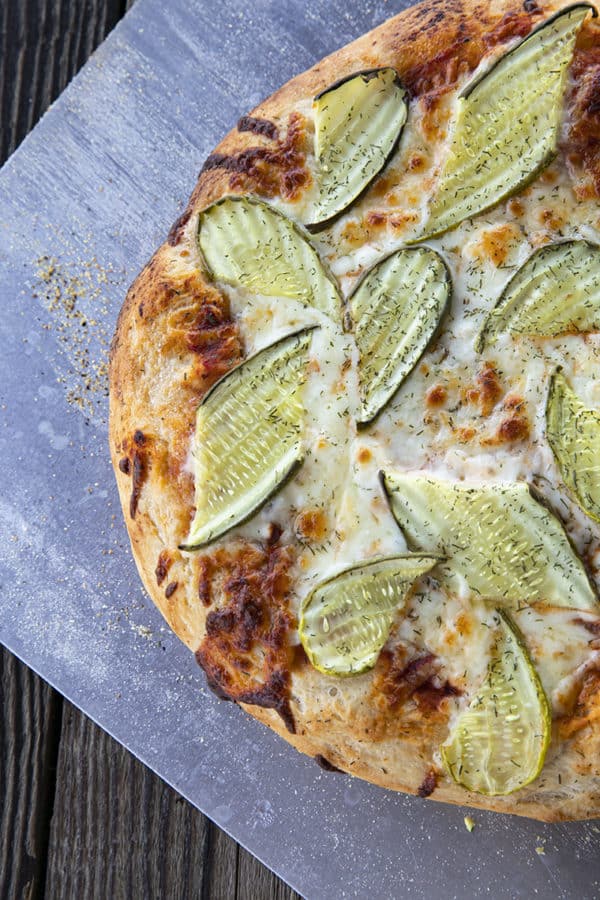
Start out by trying your half sour pickles in this Pickle de Gallo, Dill Pickle Dip, Dill Pickle Egg Salad, or Bagel Burgers with Dill Pickle Cream Cheese.
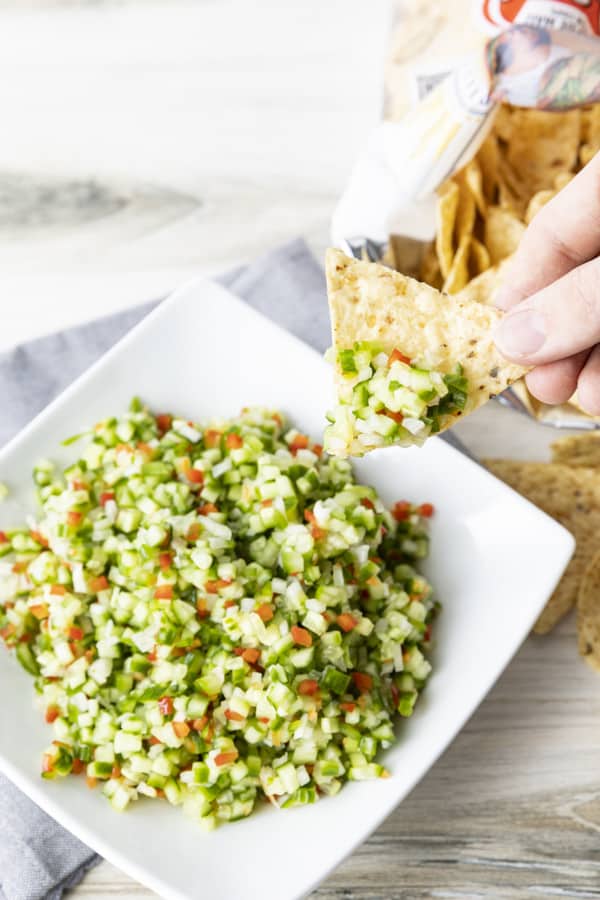
Even better, serve them on our Cheeseburger Salad or Pickle Pizza.
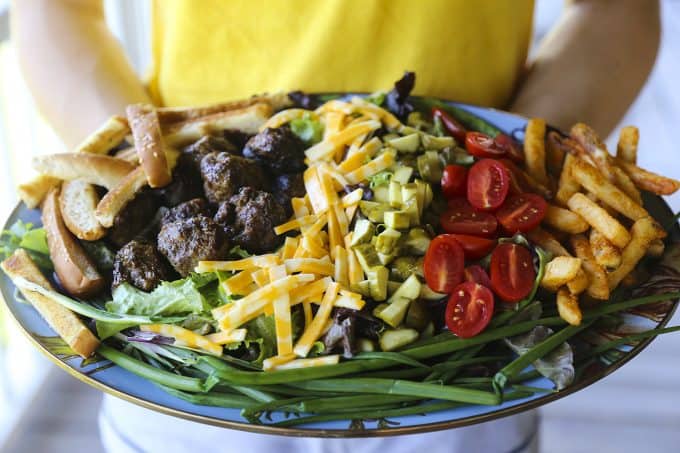
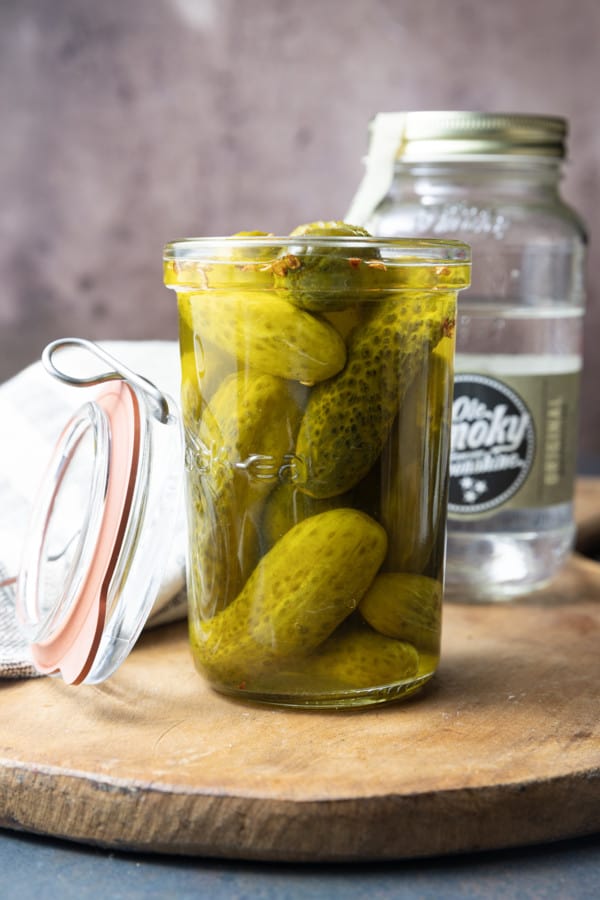
You can even take extra pickles (like that’s a thing!) and make these divine Moonshine Pickles. You’ve never had a better Bloody Mary than one made with homemade Moonshine Pickles!
Half Sour Pickle Recipe
What makes Claussen PIckles different from canned pickles? Claussen pickles, whether homemade or store bought, are a half sour pickle recipe.
That means they’re fermented instead of heat processed. That’s what gives them such great texture.
This half sour pickle recipe yields pickles that are crunchy to the point of making noise when you bite them, cold, and seriously garlicky. Canned, shelf-stable pickles can be chilled, maintain some crunch, and be as garlicky as you want them to be, but they are never, ever going to be the same thing because of science.
When you heat process a jar of pickles you are, in actuality, cooking it and a cooked pickle just plain can’t be as crunchy as an un-cooked half sour pickle recipe.
These homemade pickles keep well in the fridge for about six months, as long as they remain submerged in the brine. In our house, they never last that long because, as the saying goes, “A pickle a day keeps sad times away.”
They say that right? Someone must. If not, I’m going to start. It’s true, after all.
Claussen Pickles
Wash cucumbers but do not scrub them.
Trim 1/8-inch to 1/4-inch from the blossom end of each cucumber and slice in half lengthwise or into quarters, depending on how large your cucumbers are and how big you want them to be when they’re done.
Layer the dill heads or seed, garlic cloves, pickling spices and sliced cucumbers in a gallon jar (or large, wide-mouth, food-safe container). You can evenly divide the dill, garlic cloves, pickling spices, and cucumbers between several smaller jars if needed.
In a separate pitcher or bowl, stir together the remaining ingredients until the salt is dissolved.
Pour the brine over the cucumbers, taking care to make sure all of them are fully submerged. If needed, place a plate or mug or other non-reactive heavy item on the cucumbers to weigh them down and keep them under the brine!
Cover lightly with a lid just perched on top or secure a piece of cheesecloth over the jar with a rubber band to keep fruit flies away. Store any extra brine in a covered jar or pitcher in the refrigerator and use it to top off the brine if it starts to evaporate and expose the pickles to the air.
Leave out of direct sunlight on the counter for at least 24 hours, but up to 4 days, or until the cucumbers taste like pickles throughout.
Fix your lid onto your jar or container and chill thoroughly. These can be stored in the refrigerator for up to six months provided you keep them covered with brine.
NOTE: If at any point in the proceedings “fuzz” or “foam” develops on top of the brine, use a spoon to remove it. If there is “fuzz” attached to any of the cucumbers, remove the ones affected and be sure the others are still fully submerged.
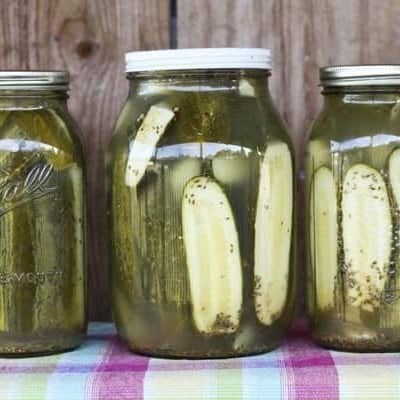
Homemade Claussen Knock-Off Pickles
Equipment
- 1 gallon jar or 4 quart jars or a large, food-safe container with a tight fitting lid
- 1 liquid measuring cup
- 1 large mixing bowl or pitcher
Ingredients
- 35 to 40 small to medium pickling cucumbers
- 1 gallon cold water
- 1 cup apple cider vinegar, preferably raw or white distilled vinegar
- 2/3 cup coarse canning or kosher salt Do NOT fine or use iodized salt!
- 4 cloves garlic or more to taste
- 4 heads fresh dill or 4 tablespoons dried dill seed not weed!
- 2 tablespoons mixed pickling spices
Instructions
- Wash cucumbers but do not scrub them.
- Trim 1/8-inch from the blossom end of each cucumber and slice in half lengthwise or into quarters, depending on how large your cucumbers are and how big you want them to be when they’re done.
- In a gallon jar (or large, wide-mouth, food-safe container) layer the dill heads or seed, garlic cloves, pickling spices and sliced cucumbers.
- In a separate pitcher or bowl, stir together the remaining ingredients until the salt is dissolved.
- Pour the brine over the cucumbers, taking care to make sure all of them are fully submerged. If needed, place a plate or mug or other non-reactive heavy item on the cucumbers to weigh them down and keep them under the brine!
- Cover lightly with a lid just perched on top or secure a piece of cheesecloth over the jar with a rubber band to keep fruit flies away.
- Leave out of direct sunlight on the counter for two to four days*, or until the cucumbers taste like pickles throughout.
- Fix your lid onto your jar or container and chill. These can be stored in the refrigerator for up to six months provided you keep them covered with brine.
- *If at any point in the proceedings “fuzz” or “foam” develops on top of the brine, use a spoon to remove it. If there is “fuzz” attached to any of the cucumbers, remove the ones affected and be sure the others are still fully submerged.
Notes
Nutrition
Nutritional information is an estimate and provided to you as a courtesy. You should calculate the nutritional information with the actual ingredients used in your recipe using your preferred nutrition calculator.
did you make this recipe?
Make sure to tag @foodiewithfam on Instagram and #hashtag it #foodiewithfamily so I can check it out!
Originally published July 22, 2011. Updated with FAQs and Troubleshooting and reposted August 2022.
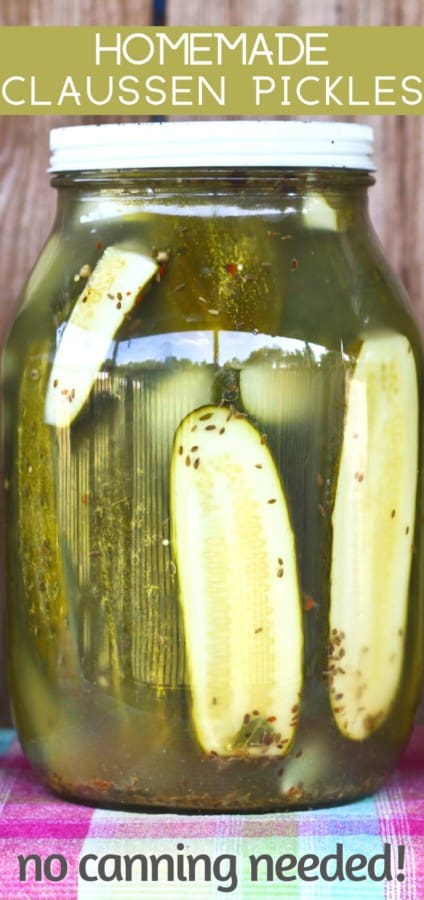
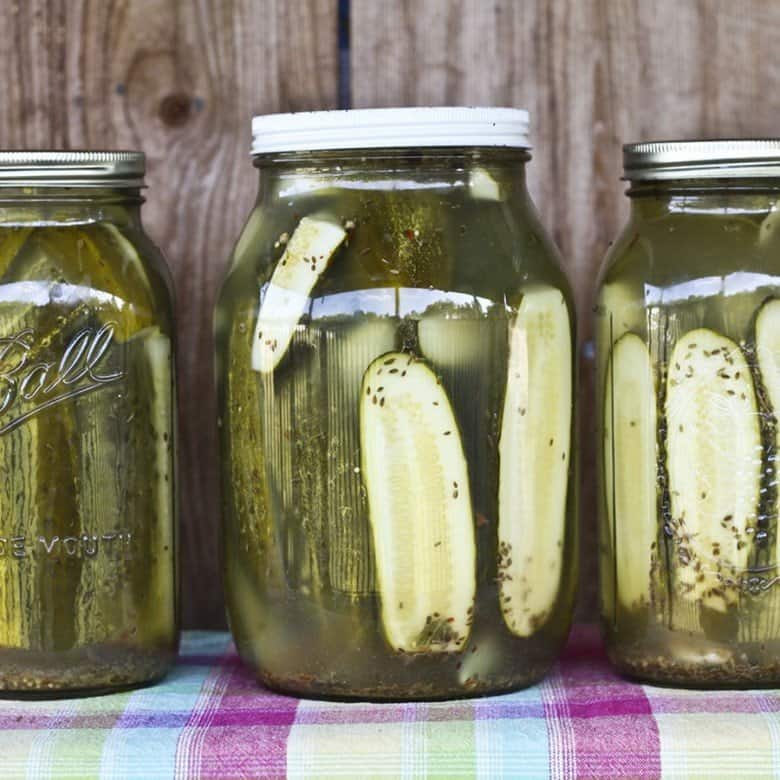
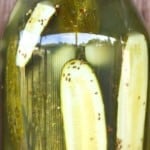



Reader's Thoughts...
Nancy says
I have been making pickles similar to these for years. I also pickle green beans and end of the season green tomatoes with the same recipe. Do you have a recipe for sweet pickles that is just as easy and crisp? Water bath sweet pickles are too mushy. Thanks
Trena Dye says
Can I put these in jars and if so how would I go about the canning? Using the recipe?
Rebecca says
Hi Trena- Unfortunately this recipe is not suitable for canning. The acidity is not the right level for shelf-stability after canning. Additionally, the pickles would suffer texturally during processing.
Deborah says
Do d
Do you have to refrigerate all the pickles or can you leave them in the brine until you are ready to start a new jar?
Rebecca says
I’m not sure exactly what you mean. When the pickles are ready to eat, you stuff the whole kit and kaboodle into the fridge; pickles, brine, all of it. I often have more than one batch going simultaneously (one in the fridge, one fermenting on the counter, etc…)
Jerry says
Rebecca, you are very kind to answer so many of the comments. I read all your readers’ comments & questions before deciding to post one of my own. I’m going to try your recipe on my garden-fresh cukes, which aren’t really pickling size – they’re big slicers, from just one plant. Our problem is the one plant is out-producing our ability to eat the cucumbers, and honestly, I’m just not a fan of raw cukes. The baby cuke plant was given to me by a gardening buddy, and I’m determined to do something with the cucumbers. I don’t expect miracles, and I will try your recipe again when my pickling size cucumber plants begin to produce. I have already shared your recipe page with my family & friends. Thank you so much for posting.
Rebecca says
Thanks so much, Jerry! I hope your cukes perform many pickled miracles for you! 😀 <3
Rob at K and R Place says
Hi from Georgia again!
I made the pickles! I actually followed the recipe, and those things are the pickles I have been wishing I could make. I brined mine a little longer, but, I’m a glutton.
My wife says that she’s drink some of the juice…in a dirty martini or a Bloody Mary. LOL!
I passed your recipe along. Thanks for a good thing.
Judy says
Could the recipe be halved? Could quart jars be used instead on gallon?
Thank you.
Rebecca says
Hi Judy- Yes you can! It’s absolutely fine to halve or even quarter this recipe. Use whatever jars you have on hand!
Jo says
Why leave the jars on the counter for 2-4 days? Why not put them in the fridge right away?
Rebecca says
The pickles need to sit at room temp for a couple of days to kick-start the fermentation process. Cold temperatures slow or stop fermentation.
Betty lutttell says
I would like to srore my for a year. Can i process them.
Rebecca says
Hi Betty-
I’m afraid these are not suitable for canning/processing both because of acidity level leaving them unsafe to store at room temperature and because the processing would make them suffer texturally.
Monica Conover says
What do you use for the “2 tablespoons of pickling spices?”
Rebecca says
I either make my own blend or pick the cloves and cinnamon sticks out of the commercially available blend before measuring it. 😀
Monica Conover says
What do you put in your own blend or what commercial blend would you suggest?
Rob at K and R Place says
Hi from North Georgia! I have trellises of cuke vines that look like kudzu. Here’s my chance to do something wonderful with them. … Can you add to the crock over a period of days, like some other fermented pickle recipes I’ve seen? … By the way, pickle juice is great for alleviating muscle cramps, is a good remedy for mild heartburn, and, your husband is right; it’s a great way to replenish electrolytes and fluids in hot weather. I’m a salt lover, too.
Rebecca says
Hi there! How fortunate you are to have those cuke vines! I would say you could probably add to the jar a bit at a time, but you might want to keep an eye on how they change visually as you add them to the jar so you know which ones are done and which aren’t. 😀
Cassidy K says
What type of cucumbers do you use to make these pickles? I’ve never made pickles before, but I love my Claussens and If I can make my own that taste just as good I’ll probably be saving some money 🙂
Rebecca says
Hi Cassidy-
I use little pickling cucumbers for this, but larger pickling cucumbers would also work if you cut them down to size. Picklers are a little different than the ones you get at the grocery store; they’re easiest to find at farmers markets and farm stands. The ones at the grocery store are usually coated in wax and a different variety that doesn’t pickle quite as well. In a pinch, I’d say you could probably sub in English cukes that are cut down to size, but I’d do a smaller batch to be sure.
elise jones says
I tried this recipe and i completely loved it!!!!!!!!!!!!!!!!!!!!!!!!! i had my daughter and i do a little taste testing we compared these pickles to vlassic garlic pickles and when i tell you you couldnt taste the difference olus these are more healthier and fresh because you control how much vinegar as well as salt that you put in its all the consumers choice. one again ijm completely satified…
Rebecca says
That is AWESOME, Elise! Thank you so much for taking the time to let me know you loved it as much as I do.
Theresa Varela says
Questions;
1) Is it alright to use coarse sea salt?
2) Is cider vinegar apple cider vinegar or something different.?
Rebecca says
Hi Theresa- You’ll want to do a little research on your salt. Try to avoid anything with iodine (which much sea salt has naturally occurring) because iodine can make pickles look funky, off-colour, and have a little off-taste. As for cider vinegar, you’re spot on. It’s variously known as cider vinegar, apple cider vinegar, apple vinegar…
Angie says
I am doing an outreach for a movie in the park, my family is sitting up a booth and we’re going to do pickle sickles (frozen pickle juice) shots of pickle juice, and the pickles in the jar we’re going to stick a wooden cabob stick in them and hand them out. My question is how can I keep the pickles good without the juice. I’m hoping you can help me with this, thanks for whatever you can tell me.
Rebecca says
Hi Angie- That sounds like fun! I am thinking that you may want to prepare double the brine for the pickles when you make them since you start the clock ticking on deterioration once you pull the pickles from the brine. I’d say you wouldn’t really want to have them out of the brine more than 4-5 hours before serving, and then you’d want them tightly wrapped in a refrigerator or cooler. If you make extra brine, though, you could keep the pickles submerged even after taking brine out for the picklesickles. By the way, I love the idea of pickle sickles!
krissie templeton says
how do I break tese measurements up for just one jar of these pickles to test and see if my kiddos will eat them??
Rebecca says
Hi Krissie- The recipe yields about a gallon of pickles, so if you want a quart, you just want to multiply the ingredients by .25
Laurie says
Can these pickles be canned (preserved)?
Rebecca says
Unfortunately, these are not suitable for canning, Laurie. They lack the proper acidity and will not hold up well to the canning process.
Leila says
I would love to try this recipe. My processed pickles are way too squishy!
One question- what kind of cider vinegar? Apple cider vinegar?
Thanks so much!
Rebecca says
Yes to the apple cider vinegar! I think you’ll love these!
Susie Davis says
I cant wait to try this it sounds delicious and easy.
And in case you aren’t aware, pickle juice is an almost instant remedy for leg cramps and charlie horses. I read that several years ago in a magazine (like Good Housekeeping) that they had done studies with college athletics and severe cramps-85% of the athletes experienced almost instant relief. I kind of poopooed it but thought I would give it a try. A few nights later I woke up with the full deal-charlie horses in my thighs, calves and feet. I stumbled to the fridge like a toddler learning to walk, swung open the fridge door (with the light blinding me) and grabbed the jar of pickle juice and guzzled it like a thirsty wino. Within 30 seconds the cramps were subsiding and I could actually make my foot go flat on the floor! Sorry if I shared too much lol.
Rebecca says
That is actually awesome knowledge because I get horrible foot cramps all the time!
Murray says
Can’t you also use the left over Claussen pickle juice and soak new cucumbers in them?
Rebecca says
Hi Murray- That’s a decent solution but won’t give you QUITE the same pickle as doing it from scratch. It’s not advisable to leave the Claussen brine out at room temperature.
Jan says
If I wanted to process these in a water bath for sealing, how long would it process for? I would like to seal the jars instead if keeping in the fridge. I don’t have room for that. Does anybody know how claussens seals their Jars? They must surely use a hot water bath.
Rebecca says
Hi Jan,
Unfortunately, this recipe is not suitable for canning as the acidity is far too low. Claussens is always in the refrigerated section, as well, and advises refrigerating their pickles, so I wouldn’t store theirs on a shelf either.